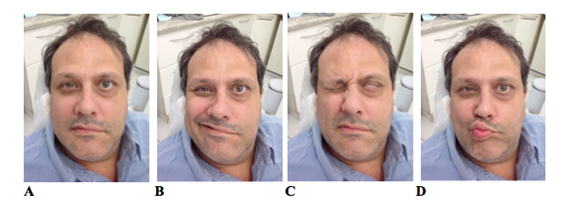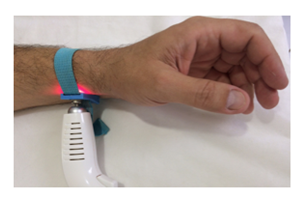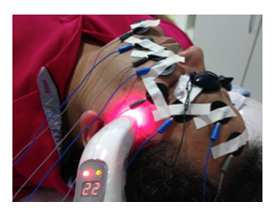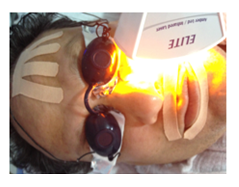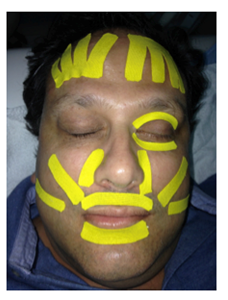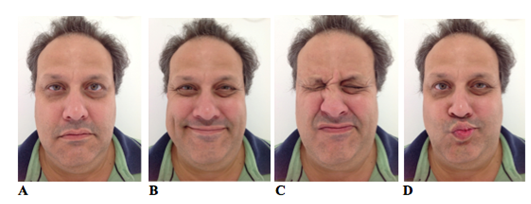Photokinesio Therapy for Orofacial Paralysis
- 1. Department of Morphology, Phisiology and Basic Pathology of Odontology, University of Sao Paulo, Brazil
Abstract
The proposal of this clinical case was present a new therapeutic approach in Oro functional Rehabilitation. Photobiomodulation using lasers and LEDs is already well known to treat peripheral nerve injury; however the proposal for this clinical case was associating low intensity laser/LED-therapy with some kinesio therapies, searching for an Orofacial rehabilitation program now called Photokinesiotherapy. During three months of treatment, the patient received 20 sessions of photo bio modulation, faradic current, functional elastic bandages (kinesiotaping), manual massages, and facial exercises at home, daily. The hemi face facial paralysis was cured, without collateral damages or invasive/surgical treatments. Photokinesiotherapy is an effective treatment program for damage to the peripheral nerve injury.
Keywords
• Photobiomodulation
• Taping
• Paralysis
• Oro functional
• Laser
• Led
Citation
de Fátima Zanirato Lizarelli R (2017) Photokinesio Therapy for Orofacial Paralysis. JSM Oro Facial Surg 2(1): 1007.
ABBREVIATIONS
PBM: Photobiomodulation; LED: Light Emitting Diode; PNI: Peripheral Nerve Injury; PKT: Photokinesio Therapy; ILIB: Intravascular Laser Irradiation of Blood; NO: Nitrite Oxide; ROS: Reactive Oxygen Species.
INTRODUCTION
Photobiomodulation employing lasers and LEDs, operating at low and medium intensity; have been established as an efficient and well-successful therapeutic modality [1-5]. Recently, some publications have shown a very interesting association: PBM and kinesio therapies. This combination seems able to shorter the time of nerve and muscle rehabilitation; besides it is capable to improve muscle performance and to keep the biological systems less intoxicated with free radicals [6-13].
Different wavelengths and spectral bands have contributed to the cellular, tissue and physiological re-equilibration. The spectral range of the near infrared laser, red light and the amber LED is very well absorbed by the cytochrome C-oxidase, promoting efficient photo-discharging of nitric oxide, which will result in a significant improvement of the cellular, tissue and local metabolism [14-16]. Lasers that emit in the infrared band (980nm) and in low intensity, have their absorption in the bio membranes, promoting a photo physical reaction of change in the polarity of these structures and changing its permeability. Besides of that, infrared band is able to promote a localized control of inflammation drainage of metabolites [17] and to induce a decrease of inflammation and an increase of new lymphatic pathways [18].
Facial Paralysis is one of the most common PNI in dentistry. Regardless of the cause that triggered it, most of the time is associated with an intense stress situation, which aggravates the patient’s anguish in recovering his capacity for normal facial expression. According to Mandelbaum-Livnat, et al. [19], the challenge is to find a treatment protocol capable of restoring the motor capacity of the injured nerve and decreasing the progression of muscle atrophy associated with this neural damage. Thus, it is very clear that it is necessary to guarantee good muscular function, stimulating its motor function, but also to stimulate nerve cell repair.
In fact, the proposal here was to combine different physiological stimuli, photonic (lasers and LEDs), electric (faradic current), mechanical (massage, functional elastic bandages and facial exercises), aiming to access different pathways to achieve the same goal in restoring nerve-muscle functional homeostasis of stomatognathic system.
CASE PRESENTATION
Patient A. J. G. J., 47 years old, male, businessman, married, sought dental care to treat orofacial hemi-paralysis. The patient had already had this same injury 10 years ago that had been solved without treatment. However, this time he had been diagnosed with Facial Neurite and underwent a surgical procedure for decompression of the facial nerve, left side. The surgeon had given 6 months to return to normal nerve and muscular activities, however, with a high degree of anxiety, the patient decided to look for an alternative treatment that shortened this waiting time.
With a 1-month postoperative period, frontal digital photographs were taken in the following situations of facial expression: at rest, smiling, with forced closing of the eyes and projecting the mouth (kiss). In this way, the neural motor activities of the facial nerve branches were observed in the following unilateral (left side) facial muscles: frontalis of the occipito-frontalis muscle, orbicular is of the eyes, major and minor zygomatic, risorius, and wing lift of the nose and upper lip and orbicularis of the mouth (Figure 1).
Figure 1: Initial frontal digital photographs: (A) at rest; (B) smiling; (C) with forced closing of the eyes; and, (D) projecting the mouth (kiss).
Photokinesiotherapy was proposed. PKT It is a program of isometric assisted and active muscle movements, associated with Photobiomodulation, lasers and LEDs, considering pre and post periods, searching for oxygenating and stimulating the repair of the tissues to be worked and draining the free radicals resulting from this work. Its main objective is muscle toning and the consequent improvement of health and functional homeostasis (toning, hydration and elasticity) of the integumentary system, skin.
Twenty treatment sessions were performed, three or two times a week, with an average duration of 90 minutes each. Firstly, ILIB (intravascular laser irradiation of blood) therapy was installed on the left wrist with the aid of a wristband, so that the red laser 660nm, 100mW output power, with active tip area of 0.28cm2 , irradiation time of 30 minutes, totaling 642.86J/cm2 on the surface of the skin on the most superficial portion of the radial artery (Therapy XT, DMC, Sao Carlos, Brazil) was installed in the patient (Figure 2).
Figure 2: ILIB (intravascular laser irradiation of blood) therapy on the left wrist.
The Intravascular Laser Irradiation of Blood (ILIB) method was first introduced in therapy by Soviet scientists E. N. Meschalkin and V. Sergiewski in 1981[20]. Originally, this method was developed for the treatment of cardiovascular diseases. The improvement of the rheological properties of the blood, as well as the improvement of the microcirculation and reduction of the infarct area has been proven. Other reductions of dysrhythmia and sudden cardiac death occurred [21]. Medical effects are determined by the predominance of systemic healing mechanisms, including biostimulating, analgesic, anti allergic, immuno reactive, antitoxic, vasodilating, anti-rhythmic, antibacterial, antihypoxic, spasmolytic, and anti-inflammatory and other properties. ILIB reduces glucose, cholesterol, lowdensity lipoprotein (LDL) and low-density lipoprotein (VLDL), and stabilizes hormonal and immune status [22].
Then, treatment session sequence was: face and neck hygiene with liquid soap based on 10% glycolic acid (Glyco-Ativo, Adcos, Brazil) and gauze moistened in saline solution, gel-cream application for facial massage (Adcos, Brazil), massage of the muscles of the face and neck (left and right side) for stretching and heating them. Then, electrodes for the application of the faradic current were fixed (Liftron II, DGM, Sao Paulo, Brazil) at the motor points of the affected muscles (left frontal, orbicular of the left eye, left major zygomatic and orbicular of the left side mouth); and, the stimulation time for the contraction of these muscles was 20 minutes, when, simultaneously, in the last five minutes, the red laser was applied, under the parameters of irradiation of 660nm and 808nm, 100mW of output power each, active tip area of 0.28cm2 , total energy of 6J per point, irradiation time of 30 seconds per point, a total of 10 points (Therapy XT, DMC, Sao Carlos, Brazil) in contact, on each muscle diagnosed with Paralysis between electrodes (Figure 3).
Figure 3: Faradic current application (Liftron II, DGM, Sao Paulo, Brazil) at the motor points of the affected muscles in combination with the red and infared laser (Therapy XT, DMC, Sao Carlos, Brazil).
After, an irradiation with infrared laser emitting 100mW of output power and cross section of the beam with 0.28cm2 of area (Whitening Laze II, DMC, Sao Carlos, Brazil) at 808nm, with total energy of 3J per point, for 30 seconds at each point, following the neural path of all branches of the facial nerve on the left side was done.
Then the entire face was again cleaned with 70% alcohol solution and gauze for the bonding of the functional elastic bandages (Therapy Tex, Innova Medical, Brazil) for the muscles undergoing treatment (left side) with excitatory stimulus for contraction. This hemiface was divided into 3 portions (TMJ region, forehead and eye region and left cheek and chin region), and each of these regions was irradiated with a hybrid system (Elite, DMC, Sao Carlos, Brazil) with 8 amber LEDs (590 + 20nm, 83mW each diode) and 2 infrared lasers (808nm, 100mW each diode) in scan mode for 5 minutes, totaling 51.84J of amber LED and 103.68J of infrared laser (60s CW + 240s pulsed) (Figure 4).
Figure 4: The bonding of the functional elastic bandages (Therapy Tex, Innova Medical, Brazil) in combination with a hybrid system with 8 amber LEDs and 2infrared lasers (Elite, DMC, Sao Carlos, Brazil).
To finish, bandages were applied on the skin of the homologous muscles (right side) with excitatory stimulus for inhibition (Fig. Solar FPS 55 (Ultra, Adcos, Brazil) was applied and the patient was discharged. The patient remained with the bandages applied for 24 hours, when they were removed (Figure 5).
Figure 5: The bonding of the functional elastic bandages (Theraphy Tex, Innova Medical, Brazil) for the muscles undergoing treatment (left side) with excitatory stimulus for contraction and on the skin of the homologous muscles (right side) with excitatory stimulus for inhibition.
At home, the patient performed isometric facial exercises for contraction of the frontal muscles, orbicularis of the eyes, orbicularis of the mouth, zygomatics and risorius.
Clinical photographs of the patient’s face, in the same situations, were performed in the first session and repeated after 5, 10, and 15 sessions and at the end of the 20 treatment sessions (Figure 6).
Figure 6: Final frontal digital photographs: (A) at rest; (B) smiling; (C) with forced closing of the eyes; and, (D) projecting the mouth (kiss).
Then, after 3 months, the treatment was finished.
DISCUSSION
PNI is one of the frequent diseases in the dental office. Whether paralyzes, parenthesis or paresis, all these situations generate huge functional, aesthetic and social discomfort to patients. In this way, the dental surgeon must offer an efficient, safe therapy that can, within a short period of time, return these patients to their normal life.
PBM using red and infrared light (lasers and/or LEDs) is already consecrated as one of the viable alternatives and that can be used as sole therapy or in association with systemic medication, for example. However, there were not yet in the scientific literature protocols combining different simultaneous stimuli with the objective of promoting a physiological response facilitated for the rehabilitation of the stomatognathic system. This clinical case presents this real and adequate possibility, without promoting collateral damages to the patient.
When PNI occurs, the muscles associated with this damaged nerve collapse, meaning these muscles go into dysfunction. Orofacial muscles, which are intimately interconnected, became dysfunctioned, so, in the case of facial neuritis, as in the clinical case presented here, the entire hemi face was dysfunctional with muscle contraction capacity, and more, as there was imbalance between the vectors of muscular forces, the excess of force on side-to-side contractions without non-paralysis was perceptible. Infrared laser irradiation can facilitate muscle contractions, increase potency [6], improve gene expression for hypertrophy and increases muscle performance during a resistance facial exercise protocol [23] and reactivates the proliferation of muscle myofibers [24].
Therefore, when this associated muscle system does not receive the necessary physiological nerve stimuli, the process of muscle atrophy begins, a biochemical situation very similar to the process of senescence or aging, when it is possible to identify the sarcopenia.
Given the central role of mitochondria in energy production, redox homeostasis, and the regulation of cellular quality control and cell death pathways, it is not surprising that alterations in mitochondrial function are considered primary instigators of myocyte atrophy during aging and disuse muscle wasting. Then, for better mitochondrial functioning, PBM with 660nm red laser or with 590 +-20nm amber LED; they were chosen because represents a spectral band with greater capacity to induce photodisruption of NO molecule from cytochrome C [15]. Red laser is able to a penetrate up to muscular level and Amber LED is able to penetrate up to dermal level, both of them are efficient to guarantee the return of the metabolic homeostasis of the tissues compromised by the neural lesion of facial nerve. Besides, under these irradiations the process of atrophy could be reversed and then tissue repair, neural and muscular, could be stimulated, returning the function to the injured (paralyzed) system, as can be observed in this clinical case.
Then, when we chose to associate other stimuli (electrical from Faradic Current and mechanical from the elastic bandages - kinesiotaping), we sought to shorten the rehabilitation time, accessing other pathways for the neuro-muscular physiological improvement and a therapy that continued the stimuli after the end of the session.
The precise effect of faradic current stimulation is to increase strength in specific muscle groups in order to provide joint stability through th recruiment of motor neurons. Faradic current stimulation maximizes the restoration of elastic properties of the holding elements by encouraging the correct parallel configurational arrangement of the collagen fibres within the cellular matrix [25]. In order to defray the onset of lactic acid accumulation (fatigue), it is necessary to provide proper ratios of rest-to-work for muscle activity.
This allows muscular contraction at or near maximum levels during repetition, without inducing (lactic acid) fatigue [26]. Thus, the combination of the therapy with the faradic current and the simultaneous irradiation with the red and infrared emitting lasers seems to be very adequate, providing a well directed mitochondrial stimulus, improving the endo cellular ATP production and draining the free radicals (stress Oxidative and nitrative) to preserve damage to muscle fibers.
The functional elastic bandages are simple and very efficient devices. They can receive a tension of up to 40%, but even with only 10% of it, once applied on the clean skin, is already capable of producing convolutions at the dermal level that result in localized lymphatic drainage and pain relief. Kinesio Taping® (KT) method was found by Japanese Dr. Kenso Kase in 1973. This method differs from other taping techniques by specially designed elastic tape which is used and applied directly on the skin in special manner in order to achieve various therapeutic effects such as mechanical correction, restoration of normal fluid perfusion, removing congestion of lymphatic fluid or hemorrhages, support for muscular activity, correction of misalignment of joints, analgesic system activation (elimination of pain cause, activation of pain inhibitors) [27,28]. In all sessions, immediately after receiving the application of functional elastic bandages, the patient was able to close the left eye (paralyzed side) and felt “lightness” throughout the left hemiface.
Prolonged periods of muscle inactivity lead to increased production of ROS, which are important signaling molecules responsible for mediating downstream muscle dysfunction and atrophy19.In view of this, whenever there is PNI and the chosen therapy is PBM, it is a “sinequanon” condition to start with amber red lights, and complete the next infrared therapy, guaranteeing increased metabolism and control in the production of free radicals. Besides, the possibility to use, simultaneously, systemic laser therapy (ILIB), maybe could perhaps shortened functional rehabilitation on the patient’s face, as presented here, reducing rehabilitation time in 50% (from 6 to 3 months).
It is not possible to suggest if without this treatment the final result of neural and muscular rehabilitation would be the same or worse, however, considering the effects of each therapy alone and having reduced rehabilitation time by 50%, this new proposal (PKT) seems to be very interesting To improve orofacial functionality, as well as the social conviviality of the patient, as mentioned by himself. This treatment had improved the life quality of the patient in a short time (3 months).
In conclusion, this presented new approach to treat PNI in Dentistry combining local and systemic PBM and others kinesiotherapies seems like a very efficient and safety protocol. Is able to recovery motor capability of Orofacial muscles, promote muscle balance and improve the general well-being of the patient. PKT could be suggested as an optional therapy to treat other disfunctions as aging of stomatognatic system or as a co adjuvant tool in cases of extensive oral rehabilitation using dental implants or after orthognatic surgeries.
ACKNOWLEDGEMENTS
We appreciate the patient’s permission to perform this publication. We also thank the financial support of the CNPq institution (Process #114735/2015-8).
REFERENCES
21. Boev SS, Selivonenko VG. The impact of the intravenous He-Ne laser therapy on the antioxidant system in patient with stable exertion angina and postinfarct cardiosclerosis. Klin Med (Mosk). 1997; 75: 30-33.
22. Makela AM. Theoretical backgrounds for light application in diabetes. Laser, Florence. 2004.
